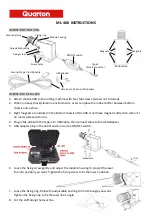
Section 4: Source-measure considerations
Model 2461 Interactive SourceMeter® Instrument Reference Manual
4-22
2461-901-01 A/November 2015
High-capacitance operation
The Model 2461 high-capacitance mode can prevent problems when you are measuring low current
and driving a capacitive load. In this situation, you may see overshoot, ringing, and instability. This
occurs because the pole formed by the load capacitance and the current range resistor can cause a
phase shift in the voltage-control loop of the instrument.
The actual operating conditions for a given capacitive load can vary. This is due to the large dynamic
range of the current measurement capability and wide range of internal resistors in the instrument.
Some test applications require capacitors larger than 20 nF. In these applications, you can use the
high-capacitance mode to minimize overshoot, ringing, and instability.
High-capacitance mode works on the 1 µA range and above.
Enabling the high capacitance feature
Before enabling high-capacitance mode, note the following:
•
Test the device under test (DUT) and the capacitor to determine the best current limit and range
of output voltages.
•
The settling times can vary based on the DUT. It is important to test the limits of the DUT before
you use high-capacitance mode.
•
Failure to test the DUT for the appropriate current limit and output voltages can result in damage
to or destruction of the DUT.
•
For optimal performance, do not continuously switch between normal mode and high-capacitance
mode.
•
Before you charge the capacitor, start with 0 (zero) voltage across the capacitor.
Using the front panel:
1. Press the
MENU
key.
2. Under Source, select
Settings
.
3. Next to High Capacitance, select
On
.
4. Select
HOME
to return to the operating display.
Using SCPI commands:
Send the command:
:SOURce:CURRent:HIGH:CAPacitance ON
To turn on high capacitance for a voltage source, replace
CURRent
with
VOLTage
.
Using TSP commands:
Set the source function, then send the command:
smu.source.highc = smu.ON
















































